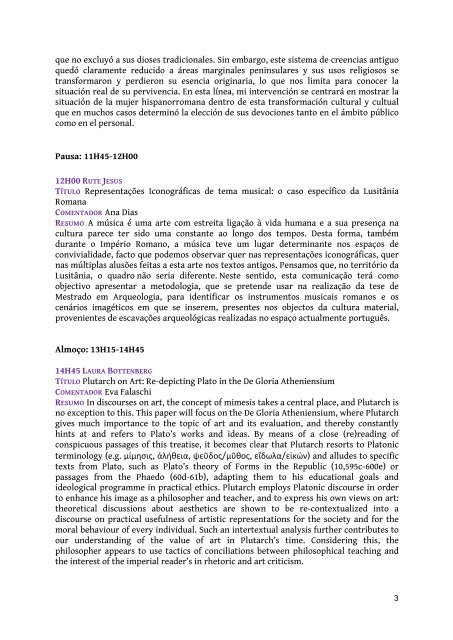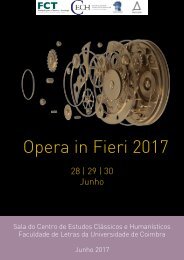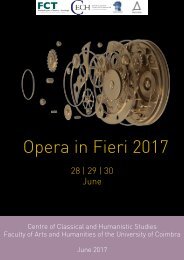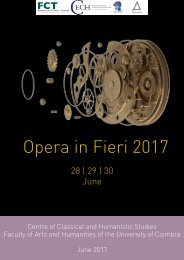Resumos PT
You also want an ePaper? Increase the reach of your titles
YUMPU automatically turns print PDFs into web optimized ePapers that Google loves.
que no excluyó a sus dioses tradicionales. Sin embargo, este sistema de creencias antiguo<br />
quedó claramente reducido a áreas marginales peninsulares y sus usos religiosos se<br />
transformaron y perdieron su esencia originaria, lo que nos limita para conocer la<br />
situación real de su pervivencia. En esta línea, mi intervención se centrará en mostrar la<br />
situación de la mujer hispanorromana dentro de esta transformación cultural y cultual<br />
que en muchos casos determinó la elección de sus devociones tanto en el ámbito público<br />
como en el personal.<br />
Pausa: 11H45-12H00<br />
12H00 RUTE JESUS<br />
TÍTULO Representações Iconográficas de tema musical: o caso específico da Lusitânia<br />
Romana<br />
COMENTADOR Ana Dias<br />
RESUMO A música é uma arte com estreita ligação à vida humana e a sua presença na<br />
cultura parece ter sido uma constante ao longo dos tempos. Desta forma, também<br />
durante o Império Romano, a música teve um lugar determinante nos espaços de<br />
convivialidade, facto que podemos observar quer nas representações iconográficas, quer<br />
nas múltiplas alusões feitas a esta arte nos textos antigos. Pensamos que, no território da<br />
Lusitânia, o quadro não seria diferente. Neste sentido, esta comunicação terá como<br />
objectivo apresentar a metodologia, que se pretende usar na realização da tese de<br />
Mestrado em Arqueologia, para identificar os instrumentos musicais romanos e os<br />
cenários imagéticos em que se inserem, presentes nos objectos da cultura material,<br />
provenientes de escavações arqueológicas realizadas no espaço actualmente português.<br />
Almoço: 13H15-14H45<br />
14H45 LAURA BOTTENBERG<br />
TÍTULO Plutarch on Art: Re-depicting Plato in the De Gloria Atheniensium<br />
COMENTADOR Eva Falaschi<br />
RESUMO In discourses on art, the concept of mimesis takes a central place, and Plutarch is<br />
no exception to this. This paper will focus on the De Gloria Atheniensium, where Plutarch<br />
gives much importance to the topic of art and its evaluation, and thereby constantly<br />
hints at and refers to Plato’s works and ideas. By means of a close (re)reading of<br />
conspicuous passages of this treatise, it becomes clear that Plutarch resorts to Platonic<br />
terminology (e.g. μίμησις, ἀλήθεια, ψεῦδος/μῦθος, εἴδωλα/εἰκών) and alludes to specific<br />
texts from Plato, such as Plato’s theory of Forms in the Republic (10,595c-600e) or<br />
passages from the Phaedo (60d-61b), adapting them to his educational goals and<br />
ideological programme in practical ethics. Plutarch employs Platonic discourse in order<br />
to enhance his image as a philosopher and teacher, and to express his own views on art:<br />
theoretical discussions about aesthetics are shown to be re-contextualized into a<br />
discourse on practical usefulness of artistic representations for the society and for the<br />
moral behaviour of every individual. Such an intertextual analysis further contributes to<br />
our understanding of the value of art in Plutarch’s time. Considering this, the<br />
philosopher appears to use tactics of conciliations between philosophical teaching and<br />
the interest of the imperial reader’s in rhetoric and art criticism.<br />
3






